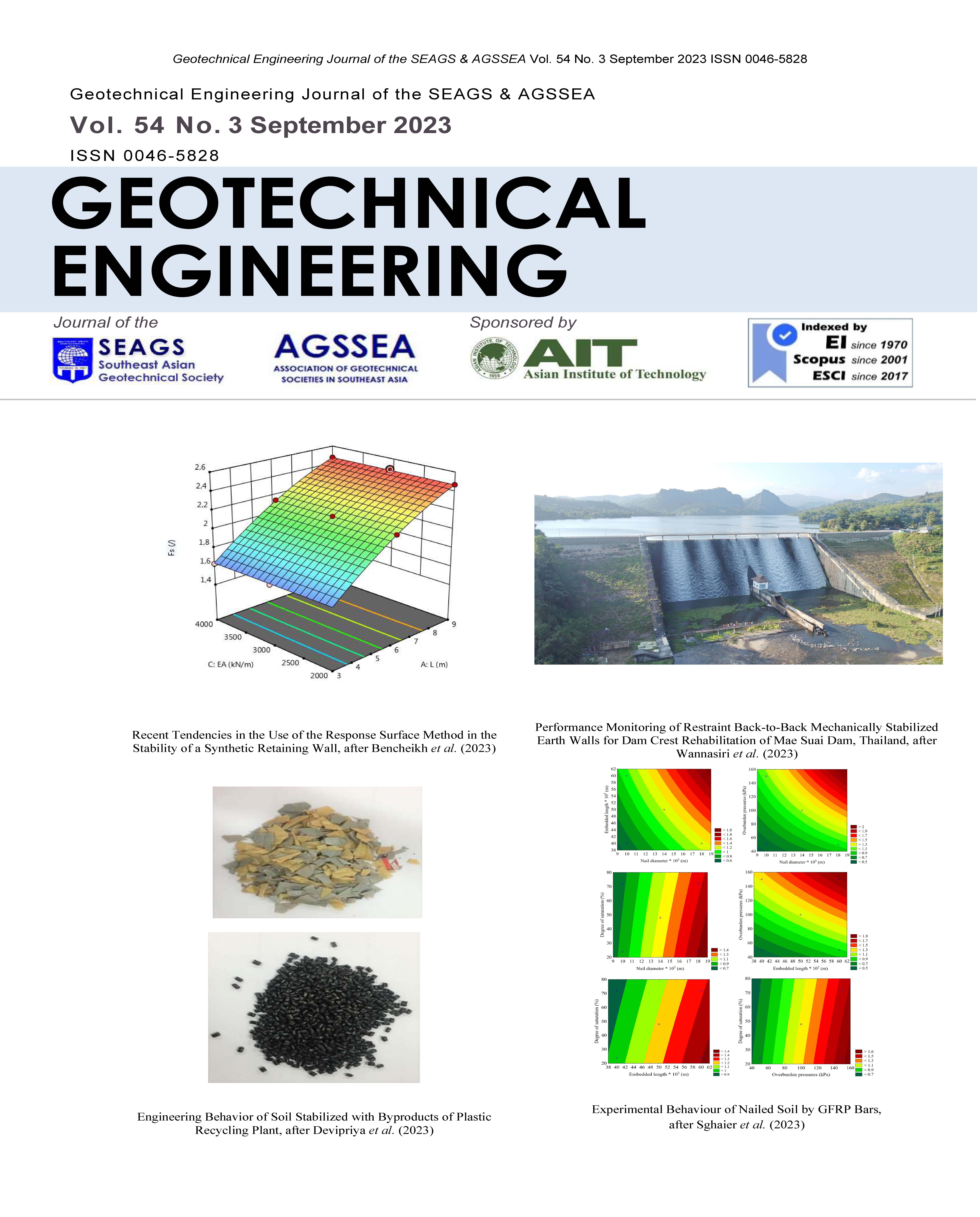Land Reclamation Management Utilizing Artificial Intelligence for Estimating Soil Properties
Main Article Content
Abstract
In use of clayey soils to effectively use clayey soils for land reclamation from the viewpoint of sustainable development, the stability against slip and future consolidation settlement should be examined during and after reclamation. For these purposes, a practical reclamation management system has been developed integrating an artificial intelligence (AI) estimation of soil properties, deposition shape analysis, and consolidation settlement analysis for clayey soils dumped from a hopper barge for reclamation. The AI technique for estimating of soil properties is characterized by use of a convolutional neural network (CNN) based on information such as soil source, wet density, and photographed image obtained before reclamation works. In this study, the validity of each analysis model in the practical system has been verified on an actual reclamation project by comparing analysis results with the measured data such as deposition shape of dumped soils on the seabed, soil properties in the reclaimed ground and monitored consolidation settlement after reclamation and soil improvement works.
Article Details

This work is licensed under a Creative Commons Attribution-NonCommercial-NoDerivatives 4.0 International License.
Copyright © 2019 Association of Geotechnical Societies in Southeast Asia (AGSSEA) - Southeast Asian Geotechnical Society (SEAGS).
References
Abdalla, J. A., Attom, M. F. and Hawileh, R. (2015): “Prediction of minimum factor of safety against slope failure in clayey soils using artificial neural network”, Environ. Earth Sci., 73 (9), pp.5463-5477.
Baghbani, A., Choudhury, T., Costa, S. and Reiner, J. (2022): “Application of artificial intelligence in geotechnical engineering: A state-of-the-art review”, Earth-Science Reviews, Vol.228, https://doi.org/10.1016/j.earscirev.2022.103991.
Chakraborty, A. and Goswami, D. (2017): “Prediction of slope stability using multiple linear regression (MLR) and artificial neural network (ANN)”, Arab. J. Geosci., Vol.10 (17), pp.1-11.
Hanna, A. M., Ural, D. and Saygili, G. (2007): “Neural network model for liquefaction potential in soil deposits using Turkey and Taiwan earthquake data”, Soil Dyn. Earthq. Eng., Vol.27 (6), pp.521-540.
Hata, K. (2022): “Evaluating tunnel rock mass using deep learning”, J. of JSCE, Vol.10, pp.260-274.
Hirai, S., Mizutani, T., Kikuchi, Y., Nakashima, S. and Iguchi, K. (2012): “Study on effect of mixing condition on strength of mixture of dredged soil and steel slag”, Advances in Transportation Geotechnics II, CRC Press, pp.302-308.
Jang, H. and Topal, E. (2013): “Optimizing overbreak prediction based on geological parameters comparing multiple regression analysis and artificial neural network”, Tunn. Undergr. Space Technol., Vol.38, pp.161-169.
Kasama, K., Zen, K. and Iwataki, K. (2007): “High-strengthening of cement-treated clay by mechanical dehydration”, Soils and Foundations, Vol.47, No.2, pp.171-184.
Kingma, D. P. and Ba, J. L. (2014): “ADAM: a method for stochastic optimization”, Proc. of the 3rd Int. Conf. on Learning Representations (ICLR), San Diego, pp.1-15.
Kit, L. C., Khoo, E., Huah, S. K., Wei, J. L. P., Tan, T. S., Tsurumi, F. and Kumagai, T. (2020): ”Reuse and recycling of clayey soil in Pasir Panjang Terminal Phase 3 & 4 Project in Singapore”, Geotech. Eng. J. of the SEAGS & AGSSEA, Vol.51, No.1, pp.32-43.
Kitazume, M. (2017): “The Pneumatic flow mixing method”, CRC Press, 250p.
Krizhevsky, A., Sutskever, I. and Hinton, G. E.: “ImageNet classification with deep convolutional neural networks in NIPS2012”, Conf. and Workshop on Neural Information Processing Systems (NIPS), Lake Tahoe, Nevada, USA, pp.1097-1105.
Kumagai, T., Bai, K., Sasaki, Y., Tashiro, T., Kotoura, T. and Tsurumi, F. (2020a): “Reclamation management system by use of artificial intelligence for estimating soil properties”, J. of Japan Society of Civil Engineers, Ser B3 (Ocean Eng.), pp.I_720-I_725 (in Japanese).
Kumagai, T., Yanagibashi, T., Tsutsumi, A., Konishi, C. and Ueno, K. (2020b): “Efficient surface wave method for investigation of the seabed”, Soils and Foundations, https://doi.org/10.1016/j.sandf.2020.04.005.
LeCun, Y., Haffner, P., Bottou, L. and Bengio, Y. (1999): “Object recognition with gradient-based learning”, Shape, contour and grouping in computer vision, Springer-Verlag Berlin Heidelberg, pp.319-345.
Robertson, P.K. (2012): “Mitchell Lecture. Interpretation of in-situ tests - some insight”, 4th Int. Conf. on Site Characterization ISC-4, Porto de Galinhas, Brazil, Vol.1, p.3-24.
Shinsha, H. and Kumagai, T. (2014): “Bulk compression of dredged soils by vacuum consolidation method using horizontal drains”, Geotech. Eng. J. of the SEAGS & AGSSEA, Vol.45, No.3, pp.78-85.
Shinsha, H. and Kumagai, T. (2018): “Material property of solidified soil grains produced from dredged marine clay”, Soils and Foundations, Vol.58, pp.678-688.
Simonyan, K. and Zisserman, A. (2015): “Very deep convolutional networks for large-scale image recognition”, In 3rd Int. Conf. on Learning Representations (ICLR 2015), pp.1-14.
Srivastava, N., Hinton, G., Krizhevsky, A., Sutskever, I. and Salakhutdinov, R. (2014): “Dropout: A simple way to prevent neural networks from overfitting”, J. of Machine Learning Research, Vol.15, pp.1929-1958.
Tsuchida, T. and Egashira, K. (2004): “The Lightweight treated soil method: New geomaterials for soft ground engineering in coastal areas”, CRC Press, 136p.


